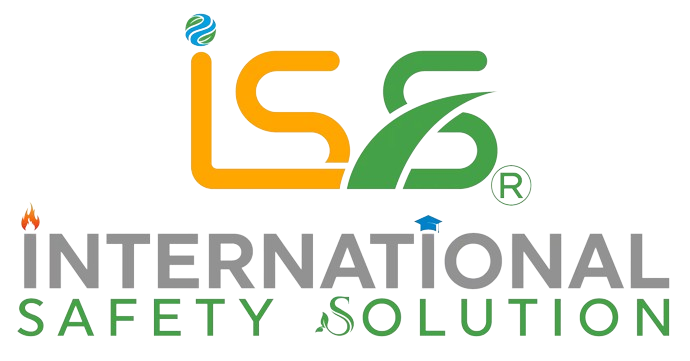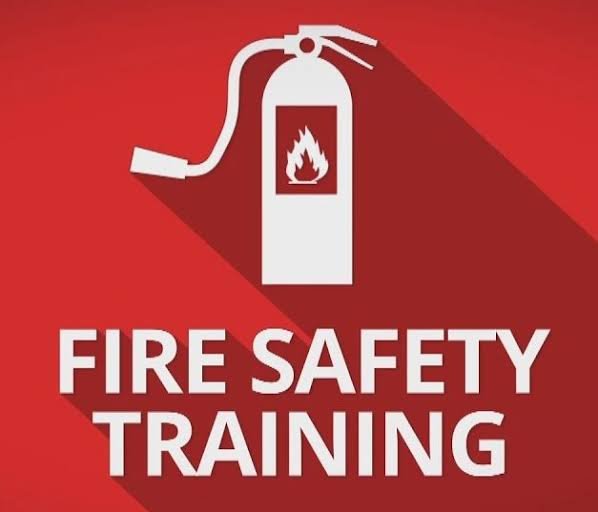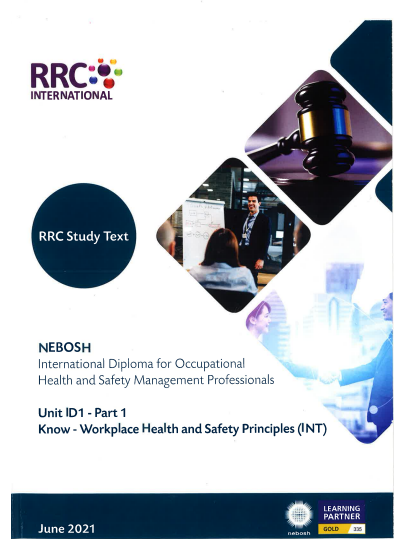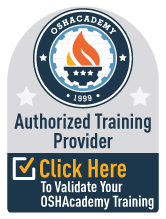NEBOSH IGC Question Paper (9 August 2023)
Discover the newest NEBOSH past paper in our blog, a crucial asset for excelling in occupational health and safety exams. Elevate your preparation with the latest official material. To view nebosh past paper, click here
Nebosh Paper Solution 9th August 2023
Task 1: Commenting on WWP’s approach to selecting contractors
Question 1
WWP’s approach to selecting contractors for the monkey enclosure construction was inadequate. Because they rapidly took a decision that might risk the project’s and everyone’s safety without knowing the constructor’s past history. There are a few indicators that WWP did not perform adequate contractor selection:
- Restrictive Evaluation Process: GM relied on an online portfolio and a friend’s recommendation, which revealed a deficiency in thorough analysis. A complete selection procedure should have included factors other than personal suggestions and internet visibility.
- Inadequate Relevant Experience: WWP chose a contractor who had no previous experience constructing animal enclosures, implying that the required knowledge was not prioritized. Contractors with similar project experience would have been better prepared to handle the complications of constructing a monkey enclosure.
- Avoiding Safety Expertise: Giving CP control over “difficult health and safety stuff” without proper supervision demonstrates an ignorance of the knowledge required to guarantee the safety of employees and visitors. This lack of consideration for safety procedures prompts worries about potential risks.
- Unsupported Confidence: CP was confident that they could finish the project despite their lack of experience constructing animal enclosures, which raised questions about the foundation for their assurance. WWP should have asked their previous work history or references for proof of their qualifications.
- Unfinished Risk Assessment: CP was given permission to conduct a risk assessment without active monitoring, raising concerns about the accuracy of the evaluation. Unexpected risks during construction can occur as a result of faulty risk assessment.
- Internal Knowledge Neglected: In determining whether CP was suitable for the project, the health and safety expertise of the GM was ineffectively applied. An internal source of knowledge that would have helped with decision-making was ignored by this failure.
- Lack of Definite Criteria: It is not clear how CP was selected for the project because WWP failed to set precise and clear selection criteria. Setting up precise and clear criteria ensures the selected contractor meets the needs of the project.
- Making Quick Decisions: The decision to hire CP right away without considering any other options shows rash decision-making by the GM. Poor project planning and execution might result from rushed decisions.
- Absence of Thorough Investigation: A lack of sufficient research was seen. GM relied on an online portfolio and a friend’s recommendation, which revealed a deficiency in thorough analysis. For minimizing risks and making wise choices, thorough research is essential.
- Neglecting Project Complexity: CP was hired by GM despite their lack of expertise in constructing animal enclosures, ignoring the challenging nature of constructing a monkey enclosure. Projects like this demand knowledge that CP might not have, such as certain design considerations, safety precautions, and animal welfare issues.
- Lack of Structured Procedure: A lack of strategic planning was seen in the absence of a formalized procedure for choosing contractors by the WWP. A well-defined approach for selecting a constructor is ensured by a clearly defined process that uses uniform standards and specifications.
- Competition Opportunity Lost: By choosing not to request bids from several contractors, WWP could be missing out on the advantages of competition, such as low costs and the opportunity for better-quality work. This decision could have resulted in passing up opportunities for better solutions.
- Neglecting Previous Clients and References: In order to confirm the quality of their CP, respect for deadlines, and general satisfaction, GM did not ask for references or get in touch with CP’s previous clients. It could have been beneficial to gain knowledge about the contractor’s performance from the experiences of those who collaborated with the contractor.
- Site Visit and Evaluation Ignored: Without performing an in-person assessment of their skills, WWP made the decision to hire CP based on their online portfolio. CP’s familiarity with the complex’s unique layout, existing structures, and difficulties may have been evaluated by WWP through a site visit.
- Neglecting Recommendations from Experienced Staff: Despite having staff members with extensive experience, such as the grounds manager, and my knowledge of health and safety, WWP did not seek out or take advantage of their suggestions during the contractor selection stage. By utilising the information and expertise they had, it could have been possible to identify issues with CP’s eligibility for the project.
- Local Laws and Permits Are Ignored: There was no mention of WWP making sure CP was aware of and in compliance with regional building laws, licences, and environmental standards. This carelessness could have caused delays and legal issues in the future.
- No Evaluation of Communication Abilities: CP was hired without considering their communication abilities with their team and with the rest of the WWP personnel; WWP’s selection of them could result in misunderstandings, delays, and improper task management.
Task 2: Commenting on negative leadership at WWP
Question 2
The scenario shows multiple instances of poor leadership at Wigmoss Wildlife Park (WWP), particularly in the areas of making decisions, interacting, and placing safety first. These significant instances of WWP’s poor leadership are listed below:
- Quick Decisions: The GM hired the CP on the rush of the moment without carefully considering their track record and previous expertise with constructing animal enclosures. The choice appeared to be driven by personal convenience and a lack of interest in considering alternative contractors.
- Absence of Diligence: The GM hired CP entirely on the basis of their internet portfolio without checking their qualifications or prior expertise in building animal enclosures. This suggests that not enough time and effort was put into finding the best contractor for the work.
- Neglecting Safety: CP informed the GM with confidence that they could manage the “difficult health and safety stuff,” despite having no prior expertise creating animal enclosures. This promise was readily accepted by GM, demonstrating their contempt for safety’s most important component.
- Poor Risk Assessment: Because of CP’s guarantee that it would handle safety concerns and the GM’s willingness to transfer safety roles, the risk assessment was not complete and did not adequately identify and manage possible dangers. The ensuing construction site accident revealed the flawed risk assessment procedure.
- Ineffective Engagement and Communication: Long-standing team members resisted the team leader’s attempts to organise daily meetings for increasing team participation and safety. The negativity of the LSTM, who discouraged participation and downplayed the endeavour, added to the resistance.
- Unresolved Issues: Due to the LSTM’s dominating presence, the team leader’s attempts to get the team to participate in talks were unsuccessful. This demonstrates an absence of communication abilities and a failure to properly deal with teamwork.
- Absence of Empathy: A lack of empathy and a disrespect for the value of teamwork were seen in the LSTM’s disrespectful behaviour towards the team’s youngest and least confident member, as well as in their request for snacks during the discussion.
- Unreliable Safety Procedures: The team leader slipped on the cafe floor due to filth and dust, but despite complaining it had not been cleaned, it reveals a lack of consistency in the park’s commitment to safety procedures.
- Neglecting Warning Signs: In the previous six months, there have been more entries in the near-miss book, which points to a trend of situations that were not adequately handled. This shows a failure to take preventative action to avoid accidents and to place warning signs in the hazardous area.
- Absence of Accountability: A lack of responsibility for the safety and wellbeing of employees was observed under the supervision of the construction site supervisor, and he looked annoyed and dismissive during the accident scene.
Absence of Supervision and Monitoring: A lack of efficient supervision and monitoring was seen in the fact that the construction site supervisor was not present throughout the forklift truck incident and employees acted in a dangerous manner. This shows a breakdown in monitoring the real-time adherence to appropriate safety standards.
Task 3: Commenting on the influence of peers
Question 3
The case at Wigmoss Wildlife Park (WWP) illustrates the importance of peers’ effect on a range of workplace factors, such as safety procedures, interaction, and team chemistry. Within the organisation, peers have a significant impact on how employees behave, think, and react. Following are some observations regarding the impact of peers at WWP:
- Safety Practices Driven by Peers: The effectiveness of daily “talks” among the employees shows how peers can affect safety procedures. Employees set an example for others to follow by reducing accidents and improving safe working conditions.
- Spreading a Positive Message: The spread of “talks” among employees provides proof of peer influence. By word-of-mouth dissemination of effective techniques gives them legitimacy and promotes adoption.
- Increase in Resistance: Resistance to change inside “The Gang” might be amplified by peer relations. The group’s tight bound could promote uniformity and make it difficult to implement new procedures.
- Impact on Team Diversity: Peer pressure can affect a team’s unity. The unified nature of “The Gang” may make it challenging for new workers, like the youngest employee, to express their ideas openly.
- Evidence of Social Influence: The LSTM’s interruption serves as an example of how peer pressure can impact conversations. The remarks from LSTM demonstrates how peer opinions can obstruct honest dialogue.
- Effect of Leadership: Taking the lead on safety is part of my job as a team leader. My peers may be inspired to adopt similar behaviors if I demonstrate the value of safety precautions and clear communication.
- Successes among Peers: Team leaders were convinced to follow the practise by the successful results of the “talks” shared by other teams. Success stories from peers may inspire change within an organisation.
- Conforming Behaviour Effects: The impact of compliance is demonstrated by the acceptance of LSTM’s advice regarding snacking. Individuals may be persuaded to follow group norms by the opinions of their peers.
- Spread of New Methods: Peer pressure speeds up the adoption of innovative techniques. Successful strategies have a tendency to spread quickly throughout an organisation when a small number of people adopt them, like the introduction of “talk” culture in the WWP.
- Change in Safety Culture: During peer-led conversations, the culture shifted in favor of safety. The discussions altered team dynamics and communication while also enhancing safety measures, like the introduction of a “talk” culture in the WWP, which reduced the accident rate.
Task 4: Determining positive indicators of health and safety culture
Question 4
Various aspects of the scenario can be used to predict positive indicators of the WWP health and safety culture. The key indicators are as follows:
- No Accidents for a Long Period: WWP has been accident-free for ten years, according to the interviewer. This reflects a long history of safety commitment and suggests a healthy safety culture where employee’s health and safety are taken seriously.
- Health and Wellbeing Benefits of Employees: WWP provides employee health and well-being benefits, according to the interviewers. These benefits demonstrate a concern for employee well-being and contribute to a strong safety culture by fostering overall wellbeing.
- Providing Health and Safety Training: The employees are offered specific health and safety training by WWP, demonstrating the company’s diligent attention to equipping staff members to identify and reduce risks. A culture of safety awareness is promoted by this dedication to training.
- Participation in Daily Safety Talks: The construction employee’s successful adoption of daily safety talks demonstrates a culture of open interaction and teamwork. These discussions develop a mutual sense of obligation and a shared dedication to safety.
- Flexible Extend and Update: The fact that WWP is able to extend and update its facilities while upholding safety requirements shows that the company has a culture that incorporates safety into its expansion plane. A strong organisational commitment to safety is highlighted by this adaptability.
- Identifying Expertise: The acknowledgement of my health and safety expertise by GM shows that the organisation prioritises subject-matter competence. This passion for expertise suggests a diligent attitude towards safety management.
- Quick Reaction to Safety Issues: The GM’s prompt response and lack of unwillingness to address safety concerns demonstrate a culture that prioritises quick action when safety is at risk. Employee trust is fostered by this attentiveness.
- Employing Near-Miss Reporting: The use of the near-miss book on a consistent basis demonstrates a culture of continual growth. This reporting system enables staff members to discuss occurrences and ideas for continuing safety improvement.
- Preventative Safety Signs: In response to the reported hazard, the placement of ‘Slippery Surface’ signage illustrates an anticipatory strategy for hazard communication. This activity demonstrates a culture that places a premium on recognising risks and controlling them.
- Arrangement for Risk Assessment: The GM arranged for CP to conduct a risk assessment of the site before construction began; this demonstrates a culture that values a thorough study of potential hazards. This focus on assessment promotes a safe working environment.
- Acknowledging Safety Leaders: The GM’s asking me if I will take on a health and safety role shows how much he values my leadership in safety-related issues. This acknowledgement promotes a mentoring and safety awareness culture.
- Acceptance of Suggestions: WWP team leaders initiating safety discussions demonstrates an environment of open talk. This readiness to consider feedback from all levels of the organisation supports a broad approach to making safety better.
- Influence on Employees Morale: After the introduction of safety discussions, it was observed that accident rates dropped and employee morale increased, which points to the relationship between employee wellbeing and workplace safety. A positive work environment is formed by this connection.
- Promoting Knowledge Exchange: By encouraging the employee to exchange knowledge, the safety talk approach promotes the dissemination of safety information. This behaviour displays a dedication to group awareness and understanding of workplace safety.
- Top Management Proactive Role: The interviewer mentioned that the chief executive meets all new workers at their thorough induction training. This dedication to shared responsibility promotes the mind-set that safety is an essential principle established across the company, encouraging employees to spot potential dangers, report occurrences, and take part in continuous improvements to safety.
- Promoting the Study of Incidents: The near-miss book has seen more entries over the previous six months, which points to a culture that values taking lessons from the past. An attitude of constant improvement is fostered by this emphasis on learning from mistakes.
- Diversity in Safety Conversations: The employees are encouraged to share ideas during safety talks, revealing a culture that supports many points of view. This approach encourages the identification and resolution of safety issues on a broad scale.
- Adopting a Proactive Attitude: During the safety talk session, the youngest team member starting to speak demonstrates a culture that encourages participation from those with less expertise. A culture of proactive safety is strengthened by this confidence in the employees.
Task 5: Explaining why a permit-to-work system should have been used
Question 5
During the construction of the monkey enclosure at Wigmoss Wildlife Park, a Permit-to-Work (PTW) system should have been utilised to mitigate the dangers involved with welding at height. An organised strategy is used in this system to manage risky work activities and guarantee that all required safety precautions are in place before work is started. In the scenario, a PTW system should have been put in place for a number of reasons:
- Identification and Evaluation of Risks: Because there is a chance for accidents, flames, and exposure to dangerous gases when welding at heights, there are inherent dangers involved. A PTW system would have needed to examine these hazards thoroughly, making sure that the right safety precautions and control mechanisms were found and put into place to successfully reduce them.
- Interaction and Teamwork: Between the numerous parties participating in the work process, a PTW system promotes interaction and teamwork. In this situation, open dialogue among the CP, the site supervisor, and the administration of the WWP would have aided in a clear knowledge of the project’s scope, potential risks, and essential safety measures.
- Clear Duty and Liability: Employees engaged in the work are given particular tasks to do under a PTW framework. Before work begins, the person who authorised the permit makes sure that the essential safety measures have been taken. Due to their responsibility, CP and the site supervisor would have been compelled to carefully evaluate the dangers of welding at a height and take the necessary precautions to protect workers.
- Workplace Environment Management: When performing welding, there are hot substances, ignitions, and blazes, all of which have the potential to cause fires or other mishaps, especially when done at a height. In order to implement a PTW system, CP would have to specify safety guidelines for welding operations, such as equipment placement for a regulated working environment, fire protection measures, and sufficient ventilation.
- Emergency Preparedness: In most cases, a PTW system involves creating an emergency reaction plan in the event of an unforeseen disaster. Given the circumstances of the case, a PTW system would have needed CP to describe a quick response plan, including evacuation protocols and medical aid arrangements, in the event of an accident.
- Regular Supervision and Monitoring: To ensure adherence to safety rules, a PTW system involves constant monitoring of the work operations. This would have made it easier to continuously monitor the building site, ensure that Personal Protective Equipment (PPE) was being used, that proper welding procedures were being followed, and that safe work practises were being followed.
- Including Health and Safety Knowledge: The situation demonstrates my proficiency in health and safety, which may have been used in the PTW procedure. My participation in the health and safety role might have resulted in a more thorough risk analysis, the discovery of potential dangers unique to welding at height, and suggestions for suitable preventive measures.
- Knowing from Experience: A monkey enclosure’s destruction by fire in the past should have served as a reminder of the value of thorough planning and risk management in all construction projects. The possible fire dangers related to welding at heights would have been thoroughly assessed if there had been a PTW system in place.
- Risk Reduction: In order to identify and put into place efficient control mechanisms and safety precautions, a PTW system would have made it easier to conduct a systematic assessment of the risks connected to welding at heights.
- Responsibility and Control: A PTW system would have made sure that safety regulations for welding at heights were carefully followed, reducing the possibility of accidents and assuring quick reaction in case of emergencies. It would have done this by establishing specific duties and continual monitoring.
Task 6: Determining management failures contributing to the accident
Question 6
Based on the scenario, the following management failures could have contributed to this accident:
- Poor Contractor Evaluation: It was an unsafe act to hire a construction company without first confirming that they have constructed animal enclosures and that they are competent in health and safety. Without further research, relying exclusively on an internet portfolio could result in contractors not properly comprehending or prioritizing safety needs.
- Improper Risk Assessment: Without supervision or approval from WWP management, the construction company was given the task of doing a risk assessment. Due to this lack of active participation in analysing and approving the risk assessment, it was possible for potential dangers to go overlooked, which contributed to the unsafe working environment on the constructing site.
- Poor Site Supervision: Due to the lack of an efficient site supervisor and oversight on the construction site, dangerous practices were allowed. The fact that a stationary forklift truck was being used as a raised platform during work operations, as well as the lack of safety equipment and other safeguards, are signs of poor supervision and management of work activities.
- Ineffective Training and Communication: Due to insufficient training and communication, it is possible that the CP employees were unaware of safety procedures, as evidenced by the risky practises on the construction site. If CP did not give its employees the right safety instruction or rules, it could result in unsafe behaviours and a disrespect for safety precautions.
- Neglecting Employee Concerns: A lack of openness to employee feedback is indicated by the CP worker’s dismissing of concerns following the accident and the site supervisor’s lack of responsiveness during the incident. If employers dismiss or ignore employee complaints, unsafe circumstances may continue and cause accidents.
- Unreliable Safety Monitoring: A lack of efficient safety monitoring and management is shown by the apparent rise in entries in the near-miss book over the previous six months. The management needs to have looked into and dealt with reoccurring problems in order to stop accidents as a result of this tendency.
- Inadequate Continuous Improvement Culture: My team, “The Gang’s” opposition to implementing daily meetings demonstrates a lack of a culture of continuous improvement. The organisation misses possibilities to improve health and safety if there is no transparent discussion and no openness to embrace new safety-enhancing methods.
- Lack of Continuous Safety Audits: Hazardous practices may go unreported and untreated in an environment due to a lack of regular safety audits and inspections to evaluate compliance with safety rules and regulations. In the scenario, the CP worker was blanching on top of the plank placed on the forklift truck, welding metal framework without any supervision, later resulting in an accident.
- Little Responsibility for Safety Standards: A lack of supervision is seen when CP is not held responsible for ensuring that safety regulations are followed on the construction site. To avoid safety failures, proper oversight of the contractor’s actions is crucial.
- Insufficient Worker Participation: Keeping workers out of safety discussions and decisions can cause a gulf between management and those doing the actual work. Workers are empowered to give insightful ideas for safer work practises through a participatory method.
- No follow-up After the Incident: The reason why the dirt path leading to the slippery floor was created after my slip incident was not sufficiently examined or remedied. Failure to investigate occurrences limits finding root causes and putting preventative measures into action, which could have contributed to this accident because if the follow-up of the incident had been taken, it could have also prevented the late accident from happening. They could have discovered the CP worker standing on top of the plank, welding a metal framework, and stopped him.
- Safety Indicators Being Ignored: In the past six months, there have been more entries in the near-miss book, which is a hint that there may be dangers to one’s safety. A major factor in the overall safety failure is the failure to act quickly to examine and minimise these indicators. If the near-miss book had been checked, further accidents could have been prevented.
Task 7: Determining the benefits of inspections
Question 7
A number of benefits may have been gained from performing health and safety inspections prior to the accident at Wigmoss Wildlife Park (WWP), which may prevented it and increased general safety. Inspecting could have benefitted WWP in the following ways:
- Detection of Hazardous Conditions: If WWP had conducted regular inspections, they would have spotted hazardous items including cables, garbage, and faulty machinery on the construction site. If these hazards had been discovered sooner, they may have been eliminated or at least reduced.
- Implementing Preventive Measures: If the inspection had been conducted, it would have made it possible for WWP to put preventative measures in place depending on the dangers found. The risky actions of the constructor who was blanching on top of the plank welding a metal framework, for instance, should have been halted, and rules for appropriate behaviour could have been enforced.
- Contractor supervision: Inspections for health and safety could have made sure that contractors followed safety guidelines. The site supervisor’s absence from the site could have been addressed during inspections to make sure that adequate control is maintained on the construction site.
- Safety Equipment Inspection: If the inspection had been conducted, it would have guaranteed that appropriate safety equipment, such as personal protective equipment for construction workers, was used. It was observed that the constructors slack sleeves slipped over gloves, which would have prevented any incidents from happening.
- Evaluation of Site-Specific Risk: Conducting Inspections enables specific location risk evaluations, ensuring that dangers relevant to each place are detected. By doing so, risks and hazards, like the risky actions of the constructor, who was blanching on top of the plank while welding a metal framework, would have been taken into account.
- Training and Information for Employees: Inspections offer a chance to talk about safety procedures and increase staff understanding. Conducting inspections and talking to the workers could have helped them better understand safety procedures.
- Cultural Change in Safety Mentality: Inspections on a regular basis foster an environment where safety comes first. Inspections that addressed problems and included workers in safety talks would have promoted a safety-conscious culture and discouraged risky behaviour.
- Timely Corrective Actions: Hazards and dangerous behaviors may have been quickly remedied through inspections. In the scenario, the site supervisor could have easily stopped the CP worker, who was blanching on top of the plank welding metal framework, lowering the likelihood of an accident.
- Assurance of Visitor Safety: Conducting regular inspections safeguards both visitors and employees. The safety of visitors entering the main entrance hall would have been guaranteed by spotting dangers close to busy areas, like the emergency exit door being partially held open with a wedge of wood and dust and dirt on its floor, which could have caused an accident.
Task 8: Determining how administrative control measures can be improved
Question 8
By putting rules, processes, and guidelines into place, administrative control measures work to manage risks while ensuring people’s safety and preventing accidents. Following are a few methods administrative control measures can be enhanced in relation to WWP and to avoid reoccurrence of the near miss in the cafe:
- Improved Cleaning Procedures: Increasing the frequency and thoroughness of cleaning schedules for all locations, particularly for areas with frequent visitors like the cafe, the tripping and slipping hazards can be avoided by routinely cleaning dust and dirt from the cafe floor.
- Specialised Cleaning Staff: Making a specific staff member in charge of cleaning and keeping the area clean this minimizes the possibility of accidents by ensuring responsibility and a quick response to leaks or spills on the cafe floor.
- Transparent Communication Channels: Efficient channels of communication should be created for reporting and dealing with possible risks. Employees should be encouraged to report spills or unclean surfaces as soon as possible, allowing for fast remediation action.
- Routine Safety Audits: The potential risks and hazards in the park’s many parts, such as the cafes and walkways, can be found by doing routine safety audits. This proactive strategy makes it possible to take immediate corrective action.
- Placement of Effective Signage: Place caution signs when noting slippery surfaces; place the signs visibly and effectively in places susceptible to spills or dirt gathering. Correct signage improves awareness and urges prudence.
- Checks for Emergency Exits: Regularly inspect emergency exits to make sure they are clear and operational. Implement mechanisms to make sure there is no obstacle in the way of the exit door and the door is clear to use.
- Thorough Understanding of Health and Safety: Employees should receive thorough training on hazard recognition, safe work procedures, and the value of keeping workplaces clean. Employees who are knowledgeable are more inclined to contribute to safety.
- Responsibility of the Supervisor: Taking responsibility for encouraging and upholding safety procedures from managers and team leaders. Their engaged participation encourages compliance and serves as a role model for other employees.
- Culture of Near-Miss Reporting: Encourage staff to share any possible hazards they come across in order to promote a culture of reporting near-miss situations. Set up a structure that encourages prompt reporting.
- Criteria for Contractor Evaluation: Create a strict process for evaluating contractors to choose them, paying particular attention to their history of health and safety. Select subcontractors who have a track record of maintaining safety standards.

Conclusion:
Successfully navigating NEBOSH papers requires a combination of thorough understanding, preparation, and effective time management. By following the tips outlined in this blog post and utilizing available study resources, you can approach your NEBOSH exams with confidence. Remember to stay calm, read the questions carefully, and demonstrate your understanding of health and safety principles through practical solutions. Best of luck on your NEBOSH journey and congratulations on taking a significant step towards a rewarding career in occupational health and safety!



